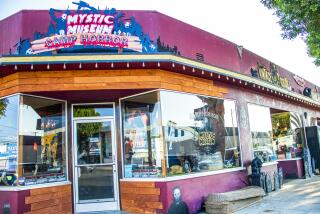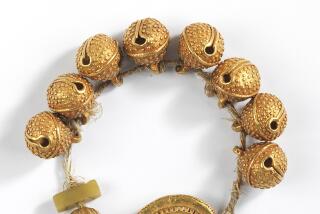In 7 Months, Iraqis Stole ‘the Very Soul’ of Kuwait : Culture: Museums were looted, zoo animals were killed. And what wasn’t taken was destroyed.
KUWAIT CITY — Iraq’s seven-month rape of Kuwait’s culture and economy was a grimly efficient affair: What the Iraqis didn’t steal, they destroyed.
At the Kuwait National Museum, Baghdad’s museum chief personally supervised the work when 17 trucks drove up to cart off one of the world’s best collections of ancient Islamic art. Then soldiers torched the buildings.
At Kuwait University, Iraqi troops patiently unbolted and carried off every single laboratory desk, sink and instrument in the chemistry and physics buildings. Then they smashed thousands of glass beakers and overturned desks and files.
Still other Iraqis stole every computer from the National Science and Technical Information Center. Then they carefully set fire to stacks of textbooks and journals in the library. What wasn’t burned was ruined by the overhead sprinklers.
“What (Iraqi President) Saddam (Hussein) did to the people of Kuwait was a crime against humanity,” said Col. Jeffrey Greenhut, the arts, monument and archives officer for the U.S. Army here. “The torching of the oil wells was a crime against the planet.
“But what he did here,” he said, pointing around the fire-gutted museum that once was a pride of the Arab world, “was a crime against civilization.
“I have devoted my life to the acquisition and dissemination of knowledge, and this makes me angry,” Greenhut added. “I want to shoot somebody.”
So did the Iraqis. At the tree-lined Kuwait Zoo in Omariya, they shot and killed two wolves and a black leopard, and wounded the elephant, Azizor. An Iraqi general personally shot a baboon after feeding a live donkey to the lions. The soldiers ate the llamas, gazelles and a porcupine. Then they brought the trucks up.
“They took a giraffe to Baghdad, the monkeys, the bears, the beautiful birds, the crocodiles, the ostrich,” said Ali Habib Mohammed Showaie, 43, a school guard who volunteered to feed and water the surviving animals.
At Entertainment City, a children’s amusement park 12 miles north in Doha, the Iraqis somehow stole the entire “Arabian Carousel” merry-go-round and mini-cars from the Grand Prix kiddie race course. The “Atom Smasher” ride was smashed.
The Iraqis overturned video games inside the Galaxy Pavilion and looted the Sinbad Magic Shop. They cut apart the honky-tonk player piano in the ersatz Old West area, and used live ammo at the Wild West Shooting Gallery.
Elsewhere, elementary schools were emptied of every desk, chair and book. Hospitals lost autoclaves and electron microscopes. Police cars and ambulances were driven off. Antitank weapons blasted the clock tower at the seaside Sief Palace, then the wood-paneled library and elegant Moorish-style buildings were torched.
The Iraqis stole the Kuwait Stock Exchange’s main computer, looted and set fire to modernistic high-rise office buildings and luxury hotels. They stole gold reserves and $1 billion in cash from the Central Bank, and emptied bank safety deposit boxes of anything of value.
“They told customers, ‘You can go open your safety deposit box,’ ” said Ghazi Mudnaf, 38, deputy general manager of a bank-owned stock and check-clearing company. “But if they find any gold, or jewelry, or foreign exchange, they took it from you.”
At the sprawling Kuwait Institute of Scientific Studies, the Iraqis stole computers, desks and files from scores of offices. Then they shot up or threw chairs through huge windows and fired weapons that gouged three-foot chunks from the concrete walls. At least one wing was set afire.
“I saw a lot of destruction in Vietnam, and if there’s any norm to war, I guess that’s it,” said U.S. Army Maj. Bill Fellows. “There’s no comparison here. This was just wanton destruction, with no reason except to destroy the economy and the culture.
“It’s not only tragic, it’s criminal,” he said. “To set fire to museums, to break into hospitals, to ransack schools, it’s an attempt to steal the very soul of the country.”
Perhaps the soul of Kuwait was its national museum. Rebuilt in 1983, the complex of four modern buildings on Arabian Gulf Street housed the famed al Sabah collection of 2,000 years of Islamic art, an extensive library and a state-of-the-art Carl Zeiss planetarium.
The collection’s 1,500 major pieces included two double-pages in Kufic (early Arabic) writing from a 2,000-year-old religious document, 10th-Century crystal chess pieces, emerald-encrusted Mongol daggers and a lace-like gold pendant from AD 8. About 2,000 ancient coins and signature stones, some dating 2,500 years before Christ, were highlights.
Hellenic columns and statues dating to Alexander the Great, and three ornate Arab pottery urns, had their own gallery. So did gilt-embroidered Kuwaiti dresses, and delicate ancient lyres and other musical instruments. All are now in Baghdad or in ashes. (Only slightly more than 100 museum pieces were on tour abroad last summer.)
“The museum is part of my life,” said Director Ibraheem Baghli. “Each part is like my son. All the rocks and trees here are my body. I feel like a father who lost his father and his self. It is very painful.”
Baghli said seven Iraqis, led by Baghdad’s general director of museums, Muaiad Saeid, arrived within hours of Iraq’s invasion of Kuwait city last Aug. 2. The museum’s huge doors were sealed with red wax and the Iraqis went to work.
“They catalogued everything inside the museum,” Baghli said. “Then they bring 17 trucks. And they take everything in the museum. Even the carpets and furniture.”
A month later, he said, they burned the museum, including art books and manuscripts in a library prized by Islamic scholars. The buildings and planetarium cost $27 million. But the collection inside was priceless.
“It’s not the money,” Baghli said. “It’s our civilization. It’s our life.”
Inside, tour guide Ahmed Tattan, 26, has returned for his first look since the invasion. In the archeological gallery, only a large potsherd and the ornate stone base of a 3,000-year-old Hellenic column from Faylakah Island, carved after Alexander the Great’s troops landed there, have survived the fire.
All else is missing, or fire-blackened rubble on the floor.
“I didn’t expect it to be this bad,” Tattan says. “I didn’t think he would destroy the museum. I’m in shock.”
The planetarium is no better. A tank fired three shells into the graceful dome. Inside, troops poured gasoline around the bone-shaped “Space Master” projector and torched it. Displays of telescopes, ancient star charts and other astronomic instruments are smashed and empty.
In the Islamic collection, Tattan pauses in alarm.
The huge room is gutted by fire. Tiles and giant pipes dangle overhead, masonry crunches under foot.
“Here, in this gallery, were priceless carpets from Turkey and Persia, from the 14th to the 17th Century,” he said. “Oh, my God. I hope they took them.”
A few feet farther, however, he stops again. Wood is charred where a huge 14th-Century engraved wooden door from Fez, Morocco, had hung. A reporter finds an iron hinge and round handle amid the cinders. The door, one of the museum’s most important pieces, is clearly burned.
“I work eight years in the Islamic Museum,” Tattan says softly. “I have no words now. They destroy everything.”
Not everything. A storage room is filled with Bedouin weavings, thrown in a heap and apparently forgotten. Next door, engraved armoires and cabinets were wrapped in plastic but never shipped.
His nation facing possible war crimes trials, Tarik Aziz, Iraq’s foreign minister, said last week that the stolen museum collection will be returned.
When and in what condition is still unknown.
So is the motivation for the sacking of Kuwait.
Baghli, the museum director, can’t explain it.
“How can soldiers destroy civilization?” he asks. “I cannot imagine a man doing this. Unless he is crazy.”
More to Read
Sign up for Essential California
The most important California stories and recommendations in your inbox every morning.
You may occasionally receive promotional content from the Los Angeles Times.











